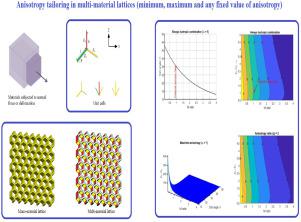Extreme Mechanics Letters ( IF 4.7 ) Pub Date : 2020-09-09 , DOI: 10.1016/j.eml.2020.100934 T. Mukhopadhyay , S. Naskar , S. Adhikari

|
This article proposes the concept of anisotropy tailoring in multi-material lattices based on a mechanics-based bottom-up framework. It is widely known that isotropy in a mono-material lattice can be obtained when the microstructure has an isotropic geometry. For example, regular hexagonal lattices with a unit cell comprised of six equal members and equal internal angle of each, show isotropy in the elastic properties. Such limited microstructural configuration space for having isotropy severely restricts the scope of many multi-functional applications such as space filling in 3D printing. We first demonstrate that there are multiple structural geometries in mono-material lattices that could lead to isotropy. It is shown that the configuration space for isotropy can be expanded by multiple folds when more than one intrinsic material is introduced in the unit cell of a lattice. We explicitly demonstrate different degrees of anisotropy in regular geometrically isotropic lattices by introducing the multi-material architecture. The contours of achieving minimum anisotropy, maximum anisotropy and a fixed value of anisotropy are presented in the design space consisting of geometric and multi-material parameters. Proposition of such multi-material microstructures could essentially expand the multi-functional design scope significantly, offering a higher degree of flexibility to the designer in terms of choosing (or identifying) the most suitable microstructural geometry. An explicit theoretical characterization of the contours of anisotropy along with physical insights underpinning the configuration space of multi-material and geometric parameters will accelerate the process of its potential exploitation in various engineered multi-functional materials and structural systems across different length-scales with the demand of any specific degree of anisotropy but limitation in the micro-structural geometry.
中文翻译:

几何各向同性的多材料晶格中的各向异性剪裁
本文提出了一种基于基于力学的自底向上框架的多材料晶格各向异性裁剪的概念。众所周知,当微结构具有各向同性的几何形状时,可以在单材料晶格中获得各向同性。例如,正则六边形格子的晶胞由六个相等的成员和相等的内角每个都显示出弹性的各向同性。这种具有各向同性的有限的微结构配置空间严重限制了许多多功能应用程序的范围,例如3D打印中的空间填充。我们首先证明单材料晶格中存在多种结构几何形状,这可能导致各向同性。结果表明,当在晶格的晶胞中引入一种以上的本征材料时,各向同性的构型空间可以扩大许多倍。通过介绍多材料体系结构,我们明确证明了规则的几何各向同性晶格中不同程度的各向异性。在由几何和多材料参数组成的设计空间中,给出了实现最小各向异性,最大各向异性和各向异性固定值的轮廓。提出这样的多材料微结构可以从本质上扩展多功能设计的范围,在选择(或识别)最合适的微结构几何形状方面为设计人员提供更高的灵活性。各向异性轮廓的显式理论表征以及对多种材料和几何参数配置空间的物理洞察力将加速其在不同长度尺度上的各种工程化多功能材料和结构系统中潜在开发需求的过程具有任何特定程度的各向异性,但在微观结构几何上受到限制。在选择(或识别)最合适的微结构几何形状方面,为设计师提供了更高的灵活性。各向异性轮廓的显式理论表征以及对多种材料和几何参数配置空间的物理洞察力将加速其在不同长度尺度上的各种工程化多功能材料和结构系统中潜在开发需求的过程具有任何特定程度的各向异性,但在微观结构几何上受到限制。在选择(或识别)最合适的微结构几何形状方面,为设计师提供了更高的灵活性。各向异性轮廓的显式理论表征以及对多种材料和几何参数配置空间的物理洞察力将加速其在不同长度尺度上的各种工程化多功能材料和结构系统中潜在开发需求的过程具有任何特定程度的各向异性,但在微观结构几何上受到限制。



























 京公网安备 11010802027423号
京公网安备 11010802027423号